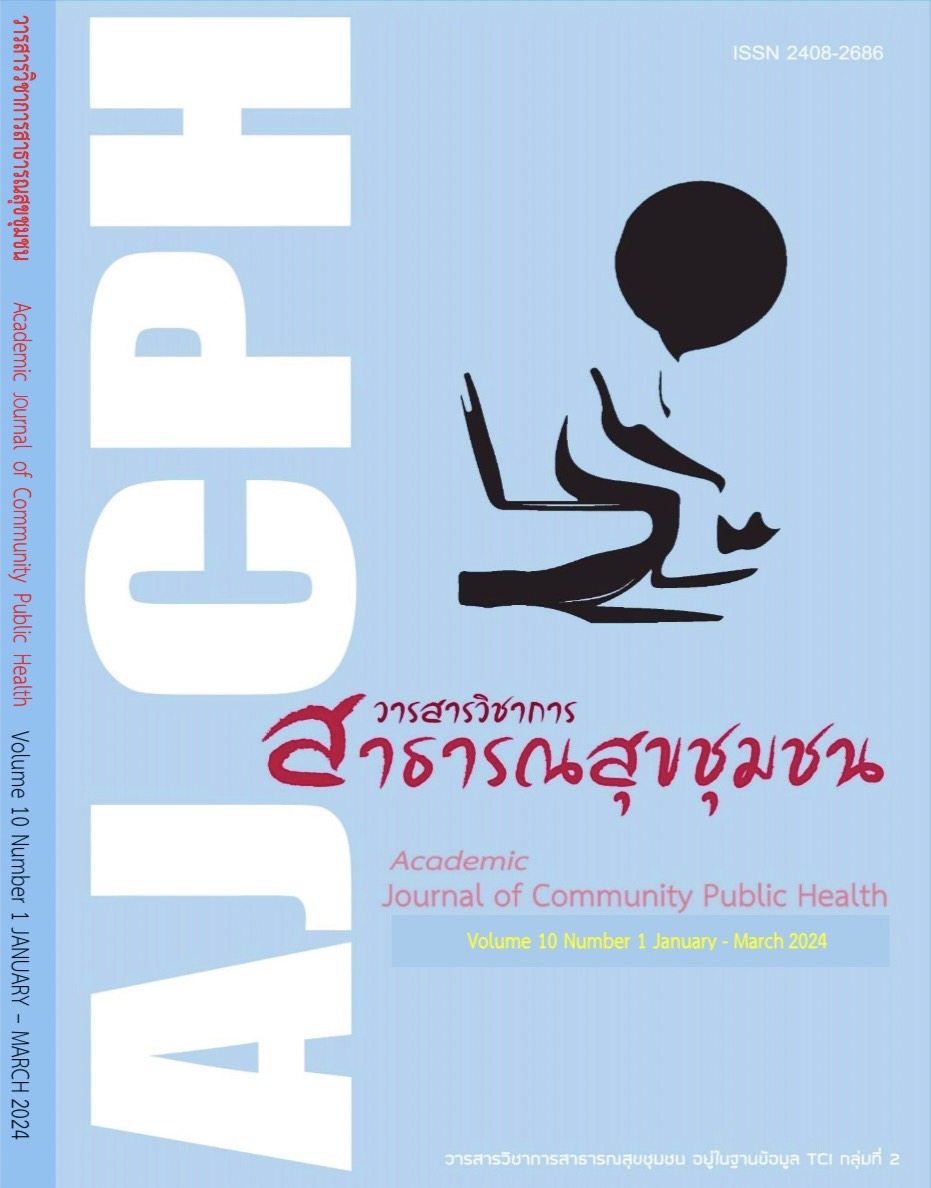การศึกษาฤทธิ์ต้านเชื้อ Bacillus cereus ในสารสกัดจากขิง
คำสำคัญ:
ขิง, บาซิลลัส ซีเลียส, ฤทธิ์ต้านแบคทีเรียบทคัดย่อ
บทคัดย่อ
ขิง (Ginger) เป็นพืชสมุนไพรที่ได้รับความนิยมในการใช้เพิ่มรสชาติในอาหารและเครื่องดื่มรวมทั้งผลิตภัณฑ์สุขภาพต่างๆ นอกจากนี้ ขิง ยังมีคุณสมบัติทางสุขภาพมากมายที่น่าสนใจ เช่น ฤทธิ์ต้านออกซิเดชันช่วยลดอาการอักเสบในร่างกาย และมีฤทธิ์ต้านเชื้อแบคทีเรีย ช่วยป้องกันการติดเชื้อแบคทีเรียในระบบทางเดินอาหารได้ดี เชื้อแบคทีเรียชื่อ Bacillus cereus เป็นหนึ่งในเชื้อแบคทีเรียที่พบบ่อยในอาหารและเป็นสาเหตุหลักของโรคติดเชื้อจากอาหาร ทำให้มีอาการอาเจียนและท้องเสีย การรักษาโรคนี้ ส่วนมากใช้ยาต้านเชื้อที่ผลิตจากสารเคมี ซึ่งมักนำเข้าจากต่างประเทศ ทำให้มีค่าใช้จ่ายสูง การค้นคว้ายาที่สกัดจากพืชสมุนไพรสามารถเป็นทางเลือกในการแก้ไขปัญหานี้ ดังนั้น การศึกษานี้ มีวัตถุประสงค์เพื่อศึกษาฤทธิ์ต้านเชื้อ Bacillus cereus ในสารสกัดจากขิง ได้ทำการสกัดสารจากเหง้าขิง (Zingiber officinale) โดยใช้วิธี Maceration ด้วย 95% เอทานอล จากผลการศึกษานี้ พบว่า สารสกัดหยาบจากขิง (ethanol crude extract) ความเข้มข้น 10 mg/ml มีฤทธิ์ยับยั้งการเจริญเติบโตของเชื้อ Bacillus cereus เมื่อเจริญเติบโตบนอาหารเลี้ยงเชื้อ MHA ซึ่งทำให้เกิดโซนการยับยั้ง 10-15 มิลลิเมตร เมื่อทดสอบด้วยวิธี disc diffusion ที่ 100-300 µg/disc ทดสอบความสามารถในการยับยั้งเชื้อด้วยวิธี microdilution method พบว่า ค่า MIC และ MBC เท่ากับ 625 และ 1,250 µg/ml ตามลำดับ มีฤทธิ์การต้านเชื้อแบคทีเรียน้อยกว่า ยา Oxacillin ซึ่งมีค่าการยับยั้งเชื้อแบคทีเรีย เท่ากับ 8 และ 16 µg/ml ตามลำดับ ดังนั้น ขิง เป็นสมุนไพรที่มีคุณค่าทางโภชนาการและสุขภาพมากมาย เป็นที่นิยมในการใช้ในด้านสุขภาพ สามารถเพิ่มมูลค่าให้กับเกษตรกรที่เพาะปลูกขิง เพื่อจำหน่ายอีกด้วย
เอกสารอ้างอิง
พืชสมุนไพรเศรษฐกิจ. (2564). กองการแพทย์ทางเลือก กรมการแพทย์แผนไทย และการแพทย์ทางเลือก กระทรวงสาธารณสุข. 1 กันยายน 2566. ขิง (ออนไลน์). เข้าถึงได้จาก https://thaicam.go.th/wp-content/uploads/2021/08/3.พืชสมุนไพรเศรษฐกิจ-2564.pdf
ฐานข้อมูลเครื่องยาสมุนไพร. (2564). ฐานข้อมูลเครื่องยาสมุนไพร คณะเภสัชศาสตร์ มหาวิทยาลัยอุบลราชธานี. 1 กันยายน 2566. ขิง (ออนไลน์). เข้าถึงได้จาก https://apps.phar.ubu.ac.th/thaicrudedrug/main.php?action=viewpage&pid=39.
Kelly, C.Z., Marcia, O.M., Adeemir, J.P. and Angela, A.M. (2002). Extraction of ginger (Zingiber officinale Roscoe) oleoresin with CO2 and co-valent: A study of the antioxidant action of the extracts. Journal of Supercritical Fluids. 24. 57-76.
Esam H.M. and Ali, H.K. (2000). Evalution of antioxidant of some plant extracts and theirs application to ground beef patties. Food Chemistry. 69. 13-141.
Patricia, F.L., Mera, E.M., Daisy, N.S., Joao, E.C., Maricia, O.M. and Angela, A.M. (2003). Functional properties of spice extracts obtained via supercritical fluid extraction. Journal of Agricultural and Food Chemistry. 51. 2520-2525.
Nguefack, J., Leth, V., Amvam, P.H. and Mathur, S.B. (2004). Evaluation of five essential oil from aromatic plant of Cameroon for controlling food spoilage and mycotoxin producing fung. International Journal of Food Microbiology. 94. 329-334.
วารีรัตน์ หนูหีต. (2557). การยับยั้งเชื้อแบคทีเรียก่อโรคที่ปนเปื้อนบนพื้นผิวสัมผัสโดยใช้สารสกัดจากพืชตระกูลขิง. วิทยานิพนธ์ปริญญาวิทยาศาสตรมหาบัณฑิต สาขาวิชาการจัดการสิ่งแวดล้อม. 94 หน้า.
Sebiomo, A., Awofodu, A.D., Awosanya, A.O., Awotona, F.E. and Ajayi, A.J. (2010). Comparative studies of antibacterial effect of some antibiotics and ginger (Zingiber officinale) on two pathogenic bacteria. Journal of Microbiology and Antimicrobials. 3(1). 18-22.
Zhang, L., Qin, M., Yin, J., Liu, X., Zhou, J., Zhu, Y. and Liu, Y. (2022). Antibacterial activity and mechanism of ginger extract against Ralstonia solanacearum. Journal of Applied Microbiology. 133(4). 2642-2654.
Park, M., Bae J. and Lee, D.S. (2008). Antibacterial activity of [10]-gingerol and [12]-gingerol isolated from ginger rhizome against periodontal bacteria. Phytotherapy Research. 22(11). 1446-1449.
Schoeni, J. and Wong, A.C. (2005). Bacillus cereus food poisoning and its toxins. Journal of mangostana Phyrochemistry. 20(1). 183-185.
กระทรวงสาธารณสุข. สาเหตุและแนวทางการแก้ปัญหาการปนเปื้อนเชื้อจุลินทรีย์ในโรงงานแปรรูปนมพาสเจอร์ไรส์.(ออนไลน์) 1 กันยายน 2566. เข้าถึงได้จาก http://www.foodsafetymobile.org/UserFiles/Documents/
Sinh Truong Nguyen, Phuc Hong Vo , Thao Duy Nguyen , Nghia Minh Do , Bao Huu Le , Duong Thuy Dinh , Kiet Dinh Truong , Phuc Van Pham.(2019). Ethanol extract of Ginger Zingiber officinale Roscoe by Soxhlet method induces apoptosis in human hepatocellular carcinoma cell line. Biomedical Research and Therapy. 6(11).3433- 3442.
Kamol YUSOOK, Pettaya PANVONGSA. (2020). Antibacterial activity of Lupinifolin from Derris reticulate and its effect on cytoplasmic membrane of Methicillin Resistant Staphylococcus aureus. Walailak Journal of Science and Technology, 17(10), 1104-1112.
Clinical and Laboratory Standards Institute. Methods for Dilution Antimicrobial Susceptibility Tests for Bacteria That Grow Aerobically, Approved Standard. Clin Lab Stand Inst Doc M07-A8. 2012;16-18.
Sharma, S., & Verma, H. N. (2019). Antibacterial activity of ginger against Staphylococcus aureus and Streptococcus pyogenes. Journal of Medicinal Plants Studies, 7(5), 64-67.
Kovačević, M., Gjorgieva, D., Stefkov, G., & Alipieva, K. (2021). Antimicrobial activity and chemical composition of selected essential oils and some of their main compounds. Molecules, 26(2), 480.



